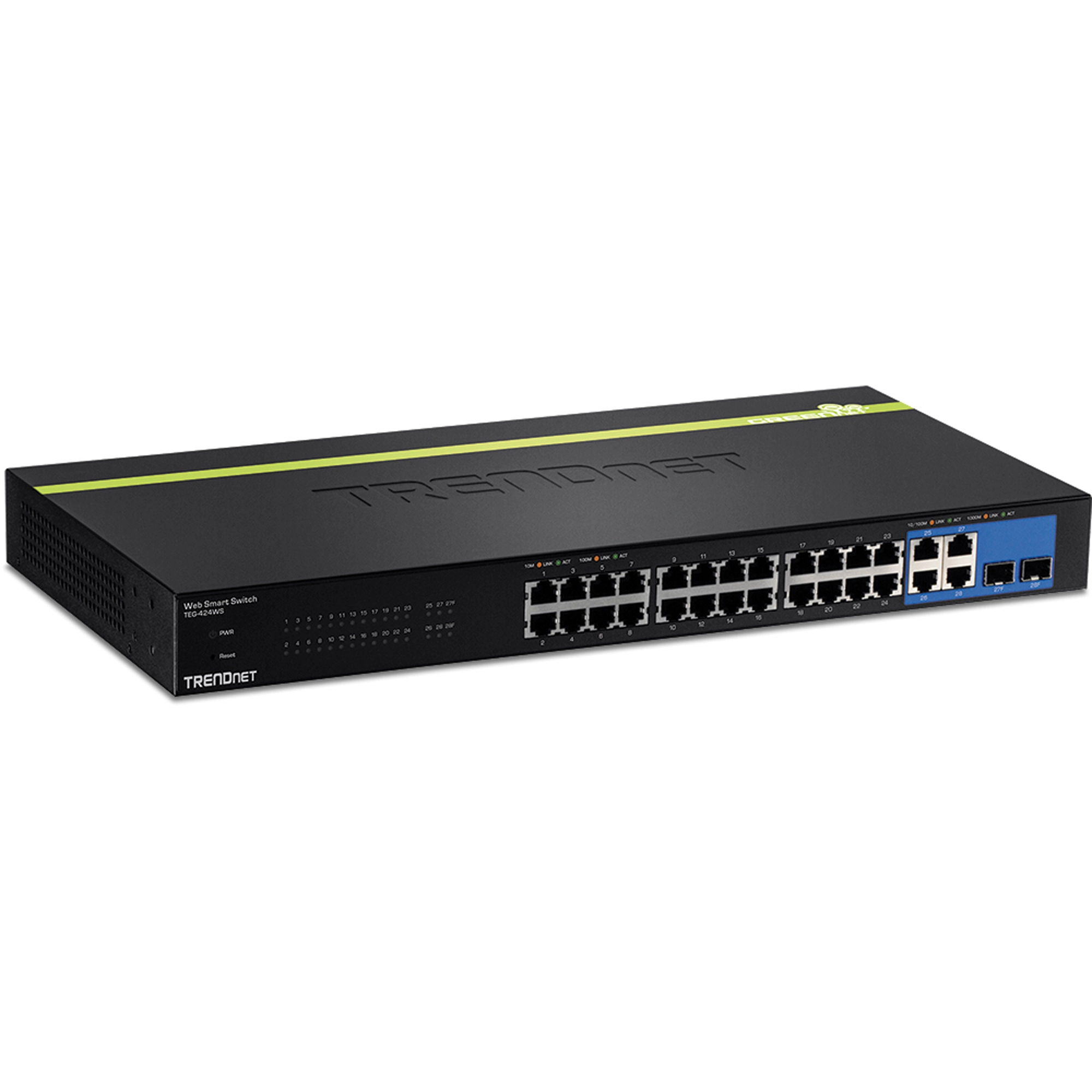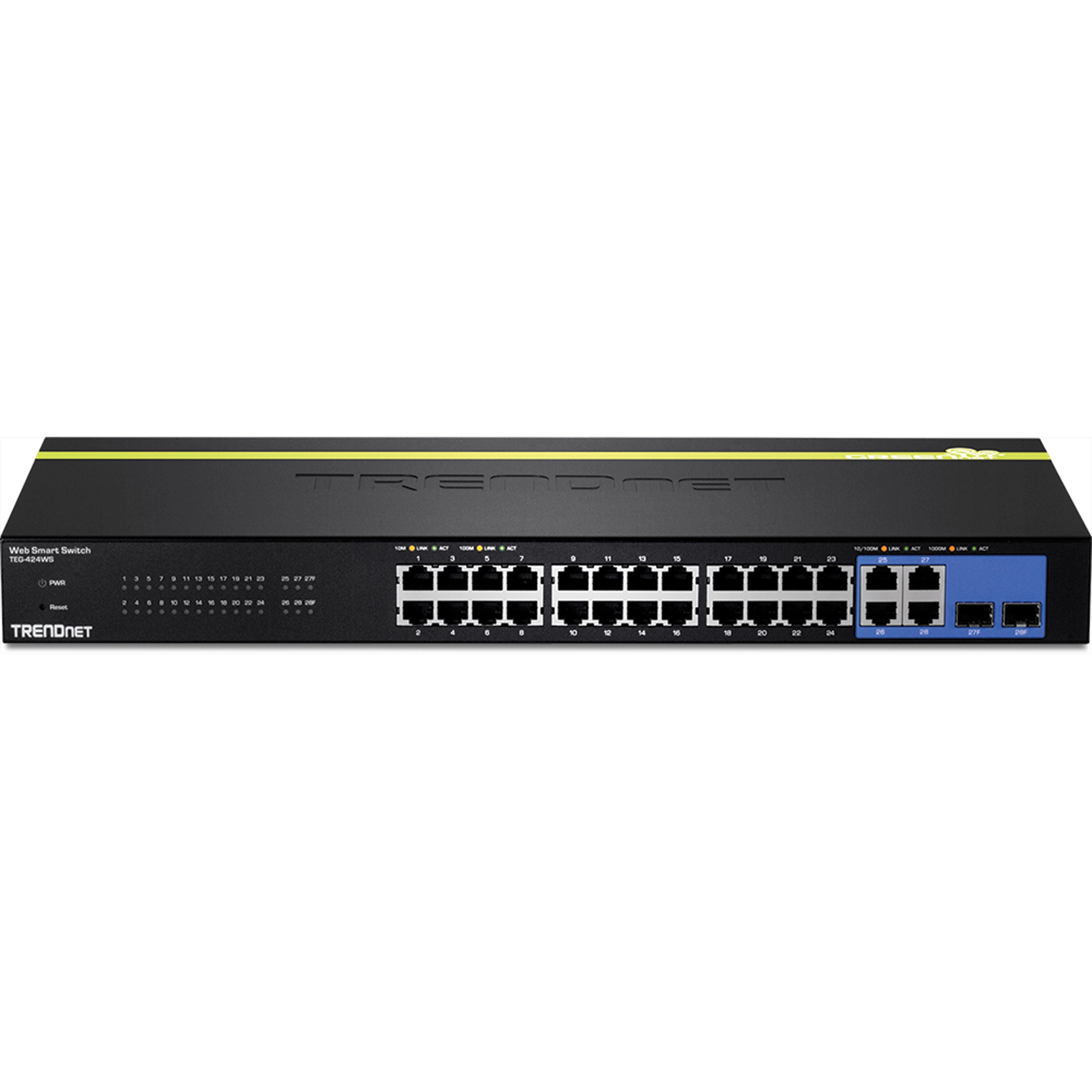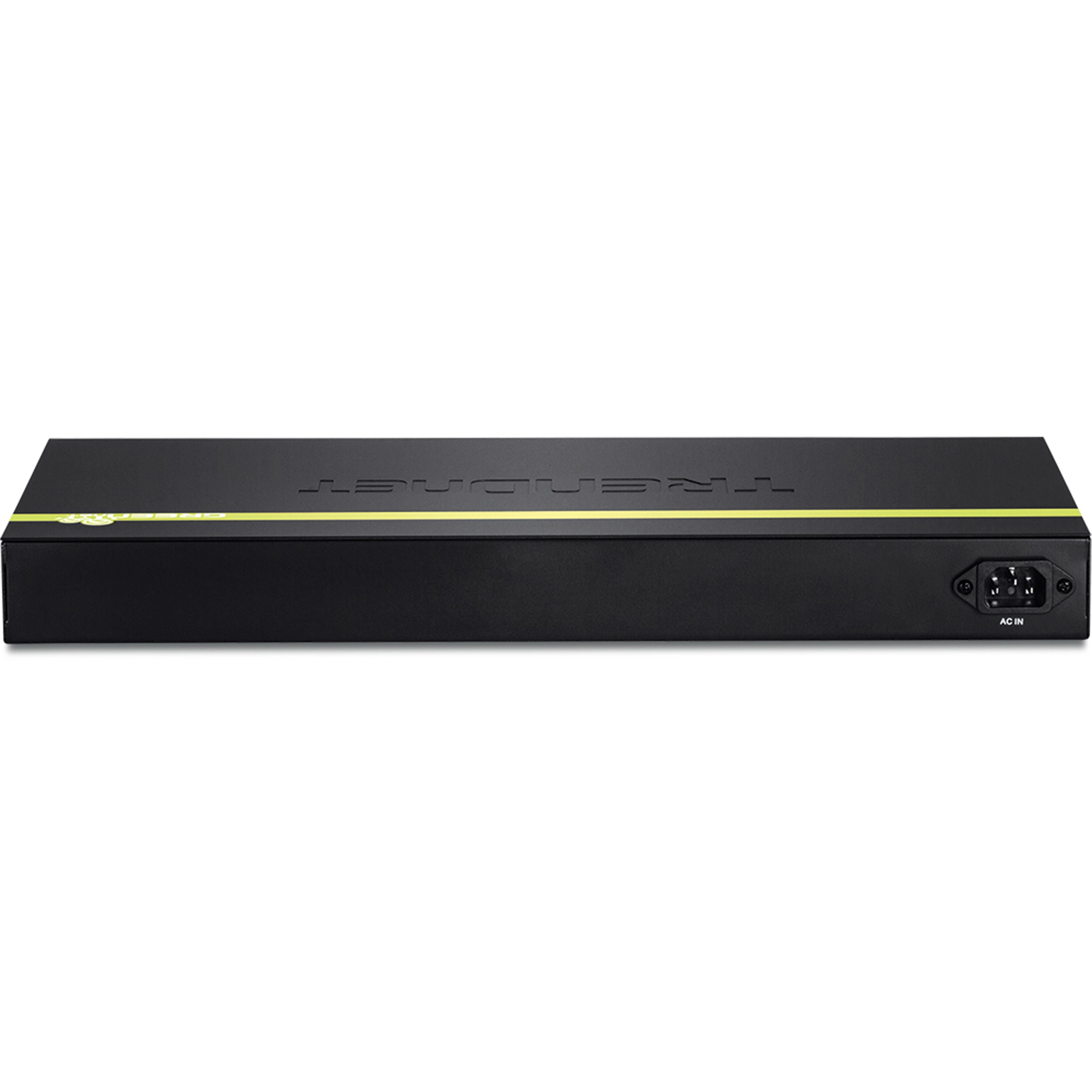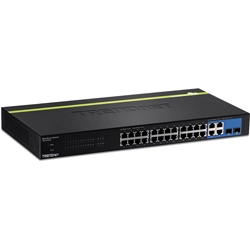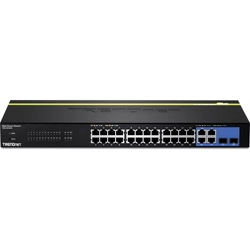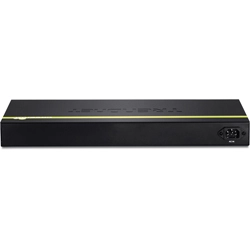Switch web smart de 24 puertos a 10/100 Mbps
TEG-424WS (Version v2.0R)
- 24 puertos de 10/100 Mbps
- 4 puertos Gigabit de enlace ascendente
- 2 ranuras SFP compartidas
- Capacidad de conmutación de 12.8 Gbps
- Administración web smart avanzada
- El diseño sin ventilador reduce el consumo de energía y los ruidos de funcionamiento
- Incluye soportes para montaje en bastidor
DISCONTINUED PRODUCT
The TEG-424WS (Version v2.0R) has been discontinued. For a list of discontinued products, click here.Utilidad
Utility Version: 3.4
Release Date: 05/2014
OS Compatibility: Windows® 8.1, 8, 7, Vista, XP, Windows® 2003/2008 Server
Note:
- Versión inicial
Nombre del archivo: Utility_WebSmartManagement(v3.4).zip
SHA-1 Checksum: E59E094A3477A78A97C44153559E02FC23141213
Fecha: 7/28/2017
Tamaño del archivo: 1.43 MB
Firmware
Firmware Version: 4.00.020
Release Date: 01/2017
Notas de la versión:
- Fixed issues accessing GUI in Mac OS 10.12 using Safari, Chrome, Firefox browsers
- Fixed issue with TEG-MGBSX H/W: v3.x SFP module will disable automatically after system reboot
- Fixed 802.3ax link aggregation issue with some network cards
- Modified SSL function to generate random certificate after system reset
- Modified default IGMP functionality to filter mode
**It is highly recommended to clear your web browser cache after upgrading due to updates in GUI layout**
Nombre del archivo: FW_TEG-424WS_v2(4.00.020).zip
SHA-1 Checksum: F3DF0C151BA2853FBC2821BE4D70A86689A1364E
Fecha: 7/28/2017
Tamaño del archivo: 8.22 MB
Other
Hoja de datos
Nombre del archivo: EN_spec_TEG-424WS(v2.0R).pdf
Fecha: 8/7/2015
Tamaño del archivo: 764.86 KB
Nombre del archivo: FR_spec_TEG-424WS(v2.0R).pdf
Fecha: 12/18/2014
Tamaño del archivo: 766.19 KB
Nombre del archivo: GE_spec_TEG-424WS(v2.0R).pdf
Fecha: 12/18/2014
Tamaño del archivo: 765.70 KB
Nombre del archivo: PO_spec_TEG-424WS(v2.0R).pdf
Fecha: 12/18/2014
Tamaño del archivo: 770.36 KB
Nombre del archivo: SP_spec_TEG-424WS(v2.0R).pdf
Fecha: 12/18/2014
Tamaño del archivo: 768.02 KB
Nombre del archivo: RU_spec_TEG-424WS(v2.0R).pdf
Fecha: 12/18/2014
Tamaño del archivo: 773.99 KB
Nombre del archivo: IT_spec_TEG-424WS(v2.0R).pdf
Fecha: 12/18/2014
Tamaño del archivo: 764.16 KB
Guía de instalación rápida
Nombre del archivo: EN_Web_TEG-424WS(V2).pdf
Fecha: 9/1/2015
Tamaño del archivo: 2.55 MB
Nombre del archivo: FR_Web_TEG-424WS(V2).pdf
Fecha: 9/1/2015
Tamaño del archivo: 2.55 MB
Nombre del archivo: GE_Web_TEG-424WS(V2).pdf
Fecha: 9/1/2015
Tamaño del archivo: 2.49 MB
Nombre del archivo: PO_Web_TEG-424WS(V2).pdf
Fecha: 9/1/2015
Tamaño del archivo: 2.47 MB
Nombre del archivo: SP_Web_TEG-424WS(V2).pdf
Fecha: 9/1/2015
Tamaño del archivo: 2.49 MB
Nombre del archivo: RU_Web_TEG-424WS(V2).pdf
Fecha: 9/1/2015
Tamaño del archivo: 2.51 MB
Nombre del archivo: ITA_Web_TEG-424WS(V2).pdf
Fecha: 9/1/2015
Tamaño del archivo: 2.50 MB
Nombre del archivo: EST_Web_TEG-424WS(V2).pdf
Fecha: 9/1/2015
Tamaño del archivo: 2.47 MB
Nombre del archivo: POL_Web_TEG-424WS(V2).pdf
Fecha: 9/1/2015
Tamaño del archivo: 2.90 MB
Nombre del archivo: RO_Web_TEG-424WS(V2).pdf
Fecha: 9/1/2015
Tamaño del archivo: 2.47 MB
Nombre del archivo: NL_Web_TEG-424WS(V2).pdf
Fecha: 9/1/2015
Tamaño del archivo: 2.50 MB
Nombre del archivo: HUG_Web_TEG-424WS(V2).pdf
Fecha: 9/1/2015
Tamaño del archivo: 2.51 MB
Guía del usuario
Nombre del archivo: UG_TEG-424WS(V2).pdf
Fecha: 8/15/2014
Tamaño del archivo: 3.31 MB
Imágenes de productos
For this example we are going to create 2 separated VLANs with a shared port.
VLAN 10: Tagged ports: 1 Untagged ports: 2 – 9
VLAN 20: Tagged ports: 1 Untagged ports: 15-20
Click Bridge > VLAN > Tagged VLAN. Input the VLAN ID and the VLAN Name under Tagged VLAN Settings. For this example...
Download the latest firmware update from our website here https://www.TRENDnet.com/support/. The firmware download will be in a compressed format. You will need to extract or unzip the file. We recommend extracting the file where you can locate it. For example, your desktop.
Open your web bro...
Press and hold the reset button located on the front of the TEG-424WS for 10 seconds to reset it to factory defaults.
...
If you encounter problems when logging into the web management interface, you may need to temporarily disable your Antivirus software. Antivirus software installed with additional web browser components (such as the AVG® Anti-Virus Surf Shield component under the LinkScanner feature) may cause probl...
When plugging in mini-GBIC modules it will automatically disable the shared copper Gigabit Ethernet RJ-45 ports. The mini-GBIC slots have priority over the RJ-45 ports and this cannot be changed....
Yes, the TEG-424WS is firmware upgradeable. To upgrade the firmware you will need to access the web interface of the unit and click on System>Firmware Upgrade. From this page you can either upload the firmware to the unit or you can back-up the firmware of the unit to a file should that firmwar...
Yes, the TEG-424WS will allow you to back-up your settings to the computer. To backup settings you will need to access the web interface of the unit and click on System>Backup Setting. From this page you can either backup the current settings to a file so that you can restore if necessary, or y...
There is not a save option for the traffic statistics however there is a visual display of the statistics. Going to System>Statistics from the web interface will give a breakdown of every port and its transfer/received okay and transfer/received error. From here you can also select on each port...
You configure traps to allow the Web Management Utility to monitor specified events and inform the SNMP managing PC. To Enable the Trap Setting features click on System>Trap Settings from the web interface. Next enable the Trap Setting options and enter in the IP address of the PC in which you w...
For the TEG-424WS there can be six trunking groups formed and in the groups it can support up to 8 ports. Ensure that the trunking group's ports are within the same VLAN group....
The TEG-424WS can support up to 256 Virtual Local Area Networks (VLAN).
Asymmetric VLAN is a mechanism to allow you to have a multiple bridged networks to transparently share the same physical network link without leakage of information between networks. It uses port tagging to enable this feature by creating a Virtual ID for a group of network port....
The benefits of using a web smart switch are the ability to utilize features such as VLAN, QoS, Trunking, IGMP, and Port Mirroring. Being able to manage these features allows the management of traffic to be controlled and therefore running a smoother network. They play an integral part for most Ethe...
Mini-GBIC slots allow network administrator to enlarge network coveragewith fiber optic network cables. Copper Ethernet cables provide up to 100 meters of distance between a network switch and its connected network devices. Using available mini GBIC modules, network administrators can extend their p...
The copper Gigabit Ethernet ports can operate at 10Mbps, 100Mbps, or 1000Mbps however the Gigabit Mini GBIC slots are strictly 1000Mbps based. Gigabit Ethernet is auto-negotiable, where as fiber is not....
There are total of 4 Gigabit Ethernet ports available on the TEG-424WS. 2 ports are dedicated for copper Gigabit Ethernet connectivity. The other two available ports are shared by two pairs of copper Gigabit Ethernet port and Mini GBIC slot. Therefore you can either have 4 copper Gigabit Ethernet po...
There are 24 10/100 Mbps ports available with 4 additional ports that are 10/100/1000Mbps. Therefore there are 28 ports that have the ability to run at 10Mbps or 100Mbps speeds....
Yes. Through the web interface in the Setup>Port Setting tab you can force ports to certain speeds and duplex mode. Below is an image of the web interface and the options it allows.
...
The default IP address of the unit is 192.168.0.1. If you forget the IP address of the unit you can log into your router and find the IP address assigned to it or you can run the utility installed from the CD. If you have installed the utility as stated by the quick installation guide, to access i...
A non-blocking switch is one that is capable of carrying all packets without delays if the backplane bandwidth exceeds the total bandwidth of the ports combined. A switch with non-blocking will allow all ports to run at its highest speed in full duplex
A blocking switch has less backplane bandwidt...
Store-and-forward switching is a method in which the switch will wait until an entire packet is received before forwarding to the destination. The switch will use its internal memory to store the packet while it then checks the destinations address, source address, and CRC to ensure there are no er...
This is a feature of the switch that will take control of the connection between devices. The switch will broadcast its available connection speeds and will also detect the connection speeds available of the device connected to it, then configure the connection to the highest performance met on both...
Auto-MDIX is an interface within the unit that will automatically detect required cable connections types (straight-through or crossover) and configure the connection appropriately. With Auto-MDIX it allows the user to not be concerned with crossover cables for connecting switches or peer-to-peer PC...
A web smart switch is a switch that has an embedded web-based interface that allows users to manage the switch. This can be done from anywhere through a standard browser such as Internet Explorer....
Port-based VLAN is a grouping based on physical ports on the switch. Each port is assigned to a specific group and if a user is moved into a different port on the switch that is not part of the VLAN group they will not be allowed to communicate with the initial group.
Tagged based VLAN is slight...
Yes it is possible to create multiple VLANs and have each one act independent of each other while still sharing a common port. Basically a VLAN is treated like its own subnet and those assigned to that group are the one able to communicate within it. One can be assured there will be no leakage of ...
The TEG-424WS does not require cross-over cabling since it supports Auto-MDIX. The Auto-MDIX feature will detect connections and configure them correctly. This eliminates the hassle of using cross-over cables. Any port can be used to cascade to another switch....
Internet Group Membership Protocol (IGMP) is a feature that allows the switch to perform intelligent multicast forwarding by examining the contents of each frame's Layer 2 MAC header. Once the switch sees a IGMP packet it will learn the MAC address of the destination and the sender so that it can l...
Port mirroring is a feature available on the TEG-424WS enabling network traffic to be examined on one of the Ethernet ports by a network administrator. Transmit or receive (or both) data traffics can be duplicated to a designated port on the TEG-424WS. Network administrators can very easily monitor ...
Trunking is using multiple ports/cables to increase bandwidth beyond the capabilities of a single port/cable. This also increases redundancy for higher availability. Trunking is usually used in switch-to-switch connectivity to increase transmission rates therefore creating bigger data pipelines fo...
The IEEE 802.1p standard is a method for assigning priority to packets traversing a network. It works with the MAC (media access control) header at the data link layer (Layer 2 in the OSI reference model). The MAC header is inspected by switches in a network, which are also responsible for different...
A broadcast storm occurs when a network is flooded with broadcast data packets and none of the network devices (workstations, servers, and other network appliances) is able to communicate. Broadcast data packet is a special packet where all network devices will receive. Broadcast data packet is comm...
VLANs can be configured using various implementations. Two prevalent VLAN implementations are MAC-based and tagged-based. As the name indicates, MAC-based VLAN allows a network administrator to create and maintain VLAN membership based on hardware MAC addresses. Tagged-based VLAN, on the other hand,...
VLAN stands for Virtual Local Area Network. The TEG-424WS offers VLAN as defined in IEEE 802.1Q standard. The TEG-424WS works with any network switch that support the same standard. VLAN allows grouping of physical workstations/servers into a logical structure regardless where systems are physically...
| Estándares |
|
|---|---|
| Interfaz del dispositivo |
|
| Tasa de transferencia de datos |
|
| Rendimiento |
|
| Administración |
|
| MIB |
|
| Spanning Tree |
|
| Agregación de enlaces |
|
| Calidad de servicio (QoS) |
|
| VLAN |
|
| Multidifusión |
|
| Port Mirror |
|
| Control de acceso |
|
| ACL IPv4 L2-L4 e IPv6 |
|
| Compatibilidad |
|
| Características especiales |
|
| Alimentación |
|
| Ventilador y acústica |
|
| MTBF |
|
| Temperatura de funcionamiento |
|
| Humedad admitida |
|
| Dimensiones |
|
| Peso |
|
| Certificaciones |
|
| Garantía |
|
CONTENIDO DEL PAQUETE |
|
Todas las referencias a la velocidad son solo para fines de comparación. Las especificaciones, el tamaño y la forma del producto están sujetos a cambios sin previo aviso, y el aspecto real del producto puede diferir del que se describe en este documento.


